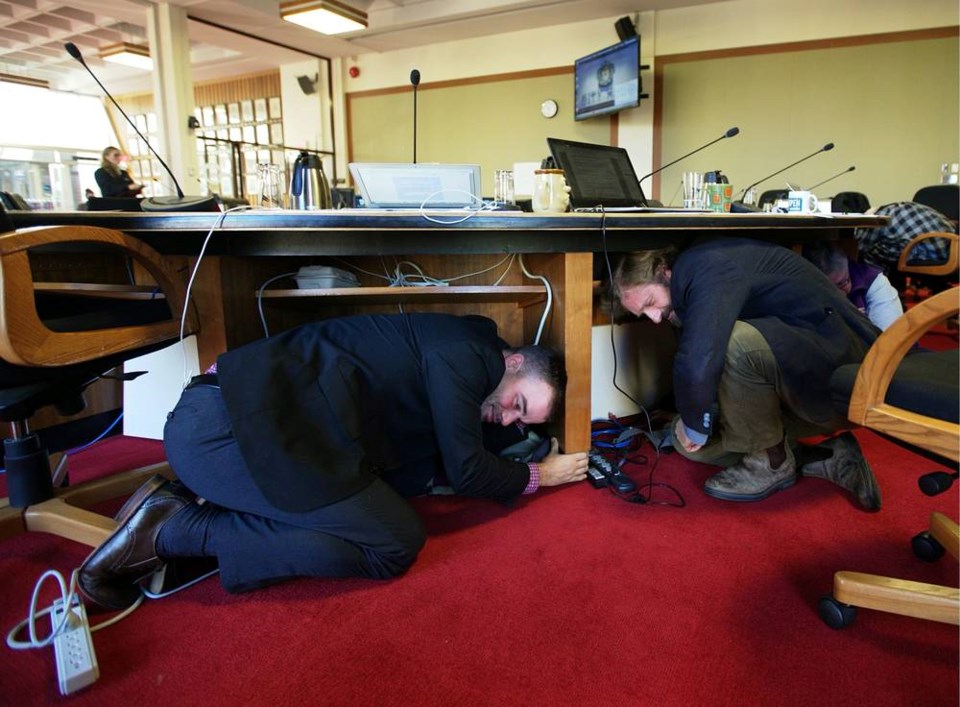An annual earthquake drill on Thursday is designed to create an automatic response to “drop, cover and hold on” in the event of a quake.
British Columbians are encouraged to take cover in a safe space on Thursday at 10:15 a.m. as part of the Great B.C. ShakeOut earthquake drill, which happens every year on the third Thursday in October.
“What we’re doing is we’re creating that muscle memory, so that our body will take us to a safe space during an earthquake. The reason for that is brains do not function very well under stress, and the instinct is to run, and that’s one of the worst things you can do in an earthquake,” said Alison Bird, an earthquake seismologist with Natural Resources Canada.
“You can can be knocked off your feet, things can be falling on you as you’re running.”
Running out of a building can be especially dangerous, because the outside edges of a building tend to sustain the most damage during an earthquake and parts of the structure may be falling from above, Bird said.
It’s best to drop to the ground and get underneath something that will protect from falling debris, cover your head and neck with one arm, and hold on with the other arm, she said. If there’s nothing in the room you can crawl underneath, go to a corner, squat down and cover your head, but stay away from hazards like windows, Bird said.
She recommends practising the drill in different rooms at home and at work to create an automatic safe response no matter where you are during an earthquake.
“It’s good to think about where you’ll go in different places. Like, if you’re in bed, we recommend actually people stay in bed, and they just cover themselves up with their pillows and blankets and everything,” Bird said.
Practising to drop, cover and hold on is just one part of building individual resilience to a potential earthquake, which can reduce the overall strain on first responders after a natural disaster.
People should also secure heavy furniture, which often pose the greatest threat in a quake if they shift or fall, and move heavy items to lower shelves, Bird said. She also suggests preparing an earthquake kit filled with food, water and everything you might need “if you were suddenly forced to camp for two weeks.”
In the event of a damaging earthquake on the Island — something Bird said is fairly likely to happen in the seismically active region — people should remain under cover until 60 seconds after the shaking stops, before cautiously coming out. Look for new hazards, expect aftershocks, and don’t make any calls unless it’s an emergency to avoid overwhelming the phone lines, she said.
Earthquakes are recorded in the Island region every day, and more than 900 are recorded each year.
“We have a fairly high likelihood of a damaging earthquake in this region. A lot of people don’t believe that because the last few decades have been relatively quiet,” Bird said, adding there were several large and damaging earthquakes in the first half of the 20th century. “So we’ve had them in the past. We’ll have them again in the future.”
The last major earthquake on the Island hit the Comox Valley in 1946 at a magnitude of 7.3 on the Richter scale. One person was killed, and the quake, felt as far away as the Rocky Mountains, caused considerable damage, Bird said.
Preparing an earthquake kit
A kit should have enough food, water and supplies to last at least 72 hours, but longer is preferable.
Important items include:
Water
Food
Radio
Wind-up or battery-powered flashlight
First aid kit
Prescription medications
Photocopies of important documents
Change of clothing and footwear
Toys and games for kids
Pet supplies
Cash
Face masks
Hand sanitizer
Toilet paper
Portable cellphone charger
Source: St. John Ambulance B.C. and Yukon



